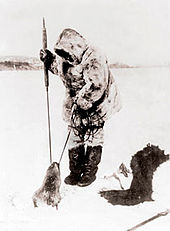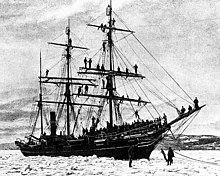Seal hunt

Seal hunting refers to the hunt for seals by humans . The seal hunters take advantage of the fact that many seals live in colonies at breeding time . Especially on islands, the seals never had to fear enemies of humans and can therefore be killed without any problems. The killing was originally carried out with metal rods, so-called hakapiks , i.e. blunt weapons, in order not to devalue the hide through bullet holes. Today, however, the hunters have predominantly switched to the use of firearms.
history

Seal hunting is a traditional way of life for hunting populations in all parts of the world where seal species are found. It was largely used by the Eskimos for self-sufficiency into modern times, and seal hunting on Gotland continued into modern times. In contrast, in the 18th and 19th centuries, Europeans decimated the large colonies of northern fur seals , southern fur seals and walruses to such an extent that many species were almost extinct. The fur was the main cause of the fur seals, the ivory of the tusks of the walrus . While these species are now under protection, harp seals in particular are now being killed.
In the North Sea area , seals were hunted into the 20th century. While the hunt was initially primarily for nutritional purposes, with the beginning of North Sea tourism it developed into pleasure and sport. In the 1970s, the hunt for seals in the area of the German North Sea coast was stopped.
Economic importance
The center of the seal hunt today is the northeast coast of Canada , where harp seals are killed to obtain fur, oil and, more recently, meat. About 12 kg of " bubbling " are extracted from the fat layer per fur . Among other things, this is used to obtain omega-3 fatty acid capsules . In 2006 Canada allowed 325,000 seals to be hunted, 95,000 of them in the Gulf of Saint Lawrence and 230,000 in the “The Front” area off Newfoundland . The quota in 2007 is 270,000 animals. The proceeds of a seal skin are 70 Canadian dollars. In 2005 it generated about $ 16 million in revenue. In view of the overfishing of the Atlantic by deep-sea fleets, the fishermen in the region see the seal hunt as an additional economic pillar and point to the growth in the stock over the past decade. The Canadian Department of Fisheries estimates the population at 5.8 million animals. The main buyers of Canadian seal skins include Norway , Denmark and the People's Republic of China .
In addition, up to 100,000 seals are hunted in Namibia every year. For the years 2010 to 2012, quotas of 86,000 animals per year were set. According to the Namibian Minister of Fisheries, the sustainable use of the Cape fur seals on the Namibian coast is not only important for the gross domestic product, but also guarantees an income for numerous people. The current population (as of 2011) is estimated at 1.5 to 3 million animals on the Namibian coast. From 2016 to 2018, 68,000 seals were released for hunting each year.
Controversy and protest
Animal rights activists have been protesting against the seal hunt for years ; the International Animal Welfare Fund , Greenpeace and other environmental organizations see it as 'senseless massacres'. As early as 1976, the actress Brigitte Bardot protested against the scope and methods of seal hunting and first made them known to a global public. Since then, images of young seals being slain with hakapiks have been in the media every year at the time of the seal hunt in April. Ex-Beatle Paul McCartney and Heather Mills were photographed with baby seals before the start of the 2006 hunting season in order to support the protest with media.
As a result of the protests in the 1980s, the hunt for very young whitecoats was officially banned in Canada in 1987. Furthermore, regulations on hunting practices are continuously improved by the Canadian government (most recently in March 2008 on the recommendation of the European Food Safety Authority) in order to ensure that hunting is as humane as possible.
In particular, it is disputed to what extent the killing of seals for fur is morally justified and the animals are immediately dead. While opponents claim that the young seals are partially skinned alive, hunters point to several independent studies that have confirmed that hunting with both hakapik and rifles is not inhumane as long as the applicable regulations are followed. For example, a study by the Independent Veterinarians' Working Group, co-financed by WWF , came to the conclusion that killing with Hakapiks looks brutal, but if done correctly, it certainly meets the standard for humane slaughter of mammals. A panel of experts from the European Food Safety Authority came to a similar conclusion in 2007 and made detailed suggestions for improving hunting practices.
In 1977 a protest against the seal hunt led to an argument between environmentalists on the ice off Canada's coast. After Paul Watson , one of the earliest members of Greenpeace , tossed the captured fur and club of a seal hunter into the water, Greenpeace excluded him from their ranks. Watson then founded the Sea Shepherd Conservation Society . Since then, this organization has been fighting against the killing of seals. Greenpeace takes the traditional self-sufficiency of the Inuit out of criticism and focuses on the professional mass slaughter of seals. This differentiation is rejected by representatives of the Inuit. Paul Okalik , former prime minister of the Canadian Arctic region Nunavut, accused animal rights activists of conveying a distorted picture of the seal hunt. He explained that the seal hunt was economically necessary and carried out in an animal-friendly manner. A ban on the import of seal goods would further aggravate the already great plight of his compatriots.
While fishermen state that the seals endanger the fish stocks in the region, critics point to the overfishing by offshore fleets, which led to the collapse of the cod stocks on the Grand Banks off Newfoundland in the 1990s. Critics point to the tourist attraction of the animal world as an economic alternative to seal hunting.
Trade ban and import restriction by the European Parliament
In the EU, Regulation (EC) No. 1007/2009 of the European Parliament and of the Council of September 16, 2009 with a ban on placing on the market, here in the sense of importing into the common market, through which provision is made for third parties against payment , for seals (and parts thereof, such as seal skins ) and seal products. EU Environment Commissioner Stavros Dimas described the decision as a clear response to "the concerns of many European citizens about the cruel methods of seal hunting". The implementation in Germany is regulated by the Animal Products Trade Prohibition Act (TierErzHaVerbG) with powers to intervene for customs and the police authorities and with regulations on fines.
In December 2014, the government of Norway decided to remove the subsidy for the Norwegian seal hunt in the amount of 1.42 million euros from the state budget. Hunting in Norway was stopped in May 2015.
See also
Web links
Individual evidence
- ↑ The seal in sight: "The strangest hunt in Europe" . In: Ostfriesland Reloaded . June 30, 2017 ( wordpress.com [accessed November 8, 2018]).
- ^ Quota set for seals, Allgemeine Zeitung, July 7, 2010 ( Memento of February 22, 2014 in the Internet Archive )
- ↑ In defense of seal culling , Die Republikein , March 23, 2011
- ↑ Seal quota renewed for three years. Allgemeine Zeitung, July 11, 2016. ( Memento from July 11, 2016 in the Internet Archive )
- ↑ http://www.antisealingcoalition.ca/resources/library/reports/IVWGReportAug2005.pdf
- ↑ https://www.efsa.europa.eu/de/efsajournal/pub/610
- ↑ - ( Memento from November 21, 2009 in the Internet Archive )
- ↑ Interview with Captain Paul Watson. "You can arrest me!" ( Memento from July 22, 2008 in the Internet Archive )
- ↑ - ( Memento from August 2, 2012 in the web archive archive.today )
- ↑ http://www.tagesspiegel.de/weltspiegel/Tierschutz;art1117,2510093
- ↑ https://www.merkur.de/welt/zr-euverbietethandel-robbenprodukte-weitgoing-277683.html . The regulation was justified with ( No. 4 ): "The hunt for seals has aroused indignation among citizens and governments who are sensitive to animal welfare issues, since the most common methods of killing and skinning seals for these animals involve pain, agony, fear and other forms of suffering. "
- ↑ Norway ends seal hunt. May 29, 2015. Retrieved April 27, 2017 .
